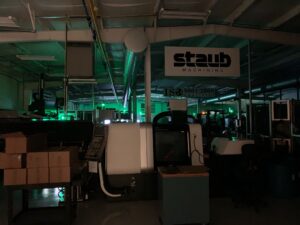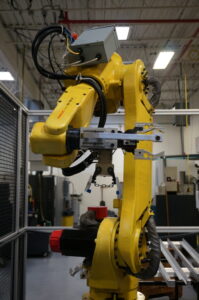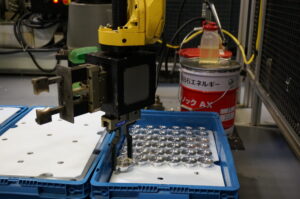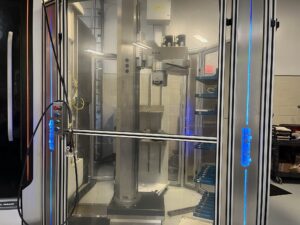As precision machining becomes ever more important in manufacturing products worldwide, the technology that makes these processes possible is tied to the increased use of automation. Manufacturing has become far less manual since robots were introduced to US factory floors in the 1960s, but many of the advancements in machine shops depend as much on software as they do on hardware. CNC (computer numerical control) technology has also progressed considerably over time, with automated manufacturing techniques allowing for lights-out manufacturing, where human operators serve in a minor supervisory role, sometimes even remotely.
 With an ever-increasing amount of production dependent on automation, manufacturing has shifted towards making these automated processes even more efficient. Historically, CNC machining was seen as a key element of automation in manufacturing, but this technology, too, has developed considerably since its introduction to machine shops in the 1940s. CNC machining processes continue to develop, producing high-quality parts and products for myriad industries and applications. Future trends involving CNC machining technology continue to bring ever greater consistency and accuracy to machine shop production floors globally, to benefit our modern world.
With an ever-increasing amount of production dependent on automation, manufacturing has shifted towards making these automated processes even more efficient. Historically, CNC machining was seen as a key element of automation in manufacturing, but this technology, too, has developed considerably since its introduction to machine shops in the 1940s. CNC machining processes continue to develop, producing high-quality parts and products for myriad industries and applications. Future trends involving CNC machining technology continue to bring ever greater consistency and accuracy to machine shop production floors globally, to benefit our modern world.
Future of Automation: Manufacturing in 21st Century Machine Shops
Once done manually, precision machining consists of turning, milling, honing, grinding, drilling, cutting, and other operations, which now involve considerable automation. Manufacturing processes use these subtractive methods to remove materials from a workpiece to meet the incredibly tight tolerances and make the surface features often necessary to produce precision components. With the continuous development of technology within the CNC machining industry, the modern machine shops that embrace automation in manufacturing offer their customers greater flexibility and efficiency. This allows them to better deal with product variations, material costs, market pressures, lead times, and evolving CNC technology.
 With CNC technology, automation in manufacturing is already seeing changes that include:
With CNC technology, automation in manufacturing is already seeing changes that include:
- Multifunctional CNC machinery: With automation, manufacturing using CNC technology has become easier, as automated tool changing and multi-axis equipment enable faster yet more accurate boring, drilling, milling, tapping, turning, and other processes, all using the same machine with many processes even done in tandem.
- Multi-axis CNC machining: Able to work on five different axes simultaneously, a 5-axis CNC machine increases efficiency, flexibility, and precision while also reducing material wastage and cycling times. The future lies in machine shops integrating equipment that can operate on even more axes, with certain specialized CNC machines currently capable of working on twelve axes at the same time.
- Manufacturing-as-a-Service (MaaS): Manufacturers often outsource to CNC machine shops due to their specialized capabilities, including having top-tier automation; manufacturing done by a contract manufacturer or other partner to which a company outsources that treats production as a service helps them concentrate on their core functions.
- Industrial Internet of Things (IIoT): A subcategory of the Internet of Things (IoT), these technologies involve embedded smart sensors that provide real-time monitoring capabilities on operational conditions of manufacturing equipment and processes. These technologies allow operators to optimize processes that further automate fabrication while supplementing worker safety and making maintenance more proactive.
- Cloud-based manufacturing: With the adoption of IIoT devices, the need for cloud-based data storage and software to support its analysis will only grow over time; smart factories rely on the cloud to improve operations and communications between production equipment, which will only continue to become more prevalent for the foreseeable future.
Many of the above fall within the category of smart manufacturing methods or are ancillary to these techniques. Digital transformation has been ongoing in the parts manufacturing industry for decades, as in other sectors, with an increasing reliance on software for automation. Manufacturing now incorporates artificial intelligence (AI), cloud computing, data analytics, IIoT, and other related technologies, which offer manufacturers real-time insights into their processes and help streamline fabrication. With the support of this ongoing digital integration, manufacturers can increase automation, benefit from using new materials, and enjoy greater precision in their processes.
More Automation in Manufacturing
Previously, manufacturers considered that only higher volume CNC machining jobs would benefit from comprehensive process automation. Manufacturing has evolved in its relationship with automated techniques, particularly CNC technology. Automation in machining operations has since become common for projects that involve repetitive work and potentially dangerous tasks when done manually, such as lifting heavy objects or changing tools on CNC machines. This speeds production on jobs with smaller throughputs, giving parts manufacturers greater flexibility and speeding up production.
The use of automation in manufacturing only continues to expand. As the industry moves towards almost complete automation, manufacturing with cutting-edge CNC machinery enables faster and more efficient performance, enabling the production of parts with complex geometries and the ability to execute complicated processes. Automated machinery and software have become important investments for companies that produce high-quality components. Not only will CNC machines become more efficient and faster in the future, but this additional automation will also continue to reduce labor costs.
Sustainability & Materials
Along with the automation inherent in CNC machining processes, AI software has enabled companies to become more efficient with the materials they use, lessening waste. The future will also see the growing use of recycled metals, biodegradable plastics, and advanced composite materials that decrease the negative impact on the environment. Though chosen for their sustainable nature, these materials won’t affect the performance and quality of components.
Greater Precision
 Technological advancements have significantly improved the accuracy of CNC machining, allowing parts manufacturers to make components of consistently higher quality. These trends for greater precision will only increase, reducing the need to rework workpieces while also leading to less waste. With the tight tolerances necessary for aerospace, automotive, medical devices, and other industries, there is a need for greater automation. Manufacturing parts within a few microns of specifications enables them to function reliably for essential applications within these and other sectors that rely on them.
Technological advancements have significantly improved the accuracy of CNC machining, allowing parts manufacturers to make components of consistently higher quality. These trends for greater precision will only increase, reducing the need to rework workpieces while also leading to less waste. With the tight tolerances necessary for aerospace, automotive, medical devices, and other industries, there is a need for greater automation. Manufacturing parts within a few microns of specifications enables them to function reliably for essential applications within these and other sectors that rely on them.
To attain greater precision, future trends for CNC machining include:
- Advances in design software that incorporate AI technology help part designers simulate machining processes to optimize tool paths better, providing greater accuracy and reducing mistakes.
- CNC technology, which enables production into the micrometer and nanometer range, allows for the extraordinarily tiny yet exact components needed for revolutionary medical devices and electronics.
- High-resolution computer vision combined with AI-enabled software permits machines to position tooling for greater accuracy.
- Hybrid machines that combine additive manufacturing methods with CNC machining will give manufacturers greater control over the fabrication of components with complex geometries and tight tolerances.
- IIoT sensors that communicate directly with automated control systems can monitor conditions in real time, adjusting to and compensating for variables like temperature changes and tool wear.
- Increasing high-performance materials like polycrystalline diamond and cubic boron nitride for tooling and specialized coatings that decrease tool wear will enable the closer tolerances needed for precision parts.
- Spindles using high-speed interpolation technology allow CNC machines to perform incredibly high speeds, enabling more precise machining of harder materials like titanium.
- Using machine learning algorithms, predictive maintenance can be performed to ensure tooling is always kept well-maintained.
- With AI-enabled automation, CNC machines can achieve greater precision and consistency by reacting in real-time to data.
Enhancing automation in CNC machines won’t just be limited to providing greater geometric precision. IIoT sensors that track tool movements, note thermal deformations, compensate for vibrations, and otherwise monitor workpiece anomalies or tooling anomalies will also increase accuracy. With thermal deformation, for example, error compensation technology can mitigate slack pitch and tooling errors, reducing processing mistakes substantially with automation. Manufacturing with these technologies will increase productivity while providing the means for dark factories to perform with minimal human intervention.
Accuracy will improve even more when these technologies work in tandem with each other, with many of these functionalities due to the greater use of automation. Manufacturing solutions are becoming increasingly integrated with the application of IIoT and other technologies, often grouped and referred to as Industry 4.0. All these elements have become part of a new industrial revolution that will augment and expand automated processes. With digital integration, one of the most revolutionary technological developments involves AI integrated within these systems to help control the movements of CNC machines and their tools.
Digital Integration
Whether referred to as Industry 4.0, digital transformation, the Fourth Industrial Revolution, or another catchphrase, the integration of automation and the technologies that support it is the future of CNC machining. AI and analytics software that rely on big data storage in the cloud are making the industry more efficient and optimizing production. The key is that IIoT sensors quietly gather data to help identify performance concerns before they become production-halting problems.
AI is already used for predictive maintenance to proactively enable manufacturers to fix issues, minimize downtime, and streamline production. With the ongoing increase in automation, manufacturing data from multiple systems and processes can be quickly analyzed and turned into valuable insights that enable better, data-driven decisions. As technology evolves, CNC machine shops should continue adopting cutting-edge solutions to improve their efficiency and quality, from the design phase to the shop floor.
Software
Key to this integration is the advanced software that supports CNC technology. Used for programming tool paths to ensure optimal accuracy in machining processes, this software continues to become more user-friendly. Software developers looking to make programming CNC machines more intuitive to lower the learning curve for learning their operation, making these complex machines more accessible. Additionally, integrating CAD (computer-aided design) software enables manufacturers to simulate their operation while still in the design phase, into which digital twin technologies are often incorporated. Meanwhile, CAM (computer-aided manufacturing) software integrations are used to create complex part designs and boost efficiency during the fabrication process.
 CNC Automation: Manufacturing with Staub Precision Machine
CNC Automation: Manufacturing with Staub Precision Machine
Staub Precision Machine was an early adopter of machining automation. Manufacturing with automated CNC machines, Staub remains at the forefront of automated technology. This includes the pride we take in having adopted many elements of lights-out production decades ago. Staub continues to quietly add more automation, manufacturing in ways that limit the need for human intervention to boost productivity and efficiency our customers. To learn more about our cutting-edge machining automation and how we can assist with your application, contact Staub today.



![Fanuc-M20IA_DSC06358-scaled[1]](https://staubinc.com/wp-content/uploads/2024/08/Fanuc-M20IA_DSC06358-scaled1.jpg)